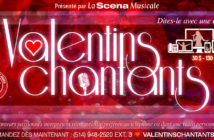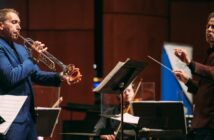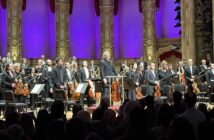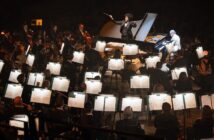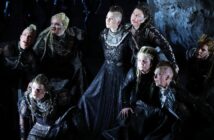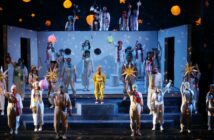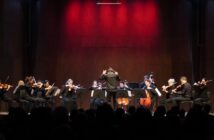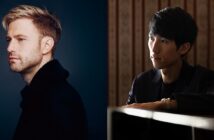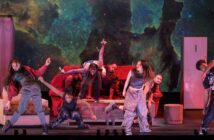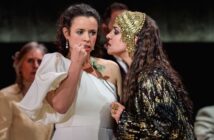
This page is also available in / Cette page est également disponible en:
![]() Francais (French)
Francais (French)
Opéra de Montréal
Tchaikovsky: Eugene Onegin
What you missed
One of the best-cast and least-tampered-with Opéra de Montréal presentations in recent memory. Australian soprano Nicole Car was admirable in every way as Tatyana. It said something about the intensity of her tone and truth of her acting style that we forgot during the Letter Scene that we were in big, cavernous Salle Wilfrid Pelletier of Place des Arts. Canadian baritone Etienne Dupuis applied a virile and vibrant tone to all of Onegin’s music. Fans of mezzo-sopranos had an array of firm sonorities to choose from in Christianne Bélanger as Larina, Stefania Toczyska as the nurse and Carolyn Sproule as Olga, who must seem the gayer of the two sisters with the darker voice. All acted well. Tenor Owen McCausland believably embodied the frustrated Lensky and (after adapting to his surroundings in Act 1) sang with pathos and ringing tone. Bass Denis Sedov, the lone Russian in the cast, portrayed Prince Gremin with a gravelly voice that seemed of a certain age – quite in keeping with the character. Adding a limp to the old general’s deportment was an inspired touch. Spencer Britten, a light tenor from the Atelier lyrique, performed a little magic show as Monsieur Triquet. The OdM chorus as prepared by Claude Webster was hearty.
Gripes
The directors could not resist deploying a few clichés of modern stagecraft, notably the use of silent senior-citizen Doppelgängers who view their younger selves with sadness. All this does is drain the plot of its natural suspense. And there was surely no need to turn the chorus into a mob, abstractly persecuting Onegin and pointing at the audience. Presumably the Orchestre Métropolitain strings got their act together for performances after the premiere of Sept. 14. (Wind standards were high.) A conductor of big gestures and no baton, Guillaume Tourniaire manipulated tempos to dramatic effect in the Letter Scene. The polonaise, on the other hand, was brittle and fast. AK
Toronto Symphony Orchestra
Brahms and Strauss
One might almost characterize the evening (Sept. 17) as a contrasting pair of concerts despite the common thread of German romanticism. Brahms’s Symphony No. 3 came first and got the once-over-lightly treatment. Guest conductor Donald Runnicles decreed a quick tempo in the first movement. Woodwinds eked out some lyricism in the second theme despite the conductor’s apparent indifference to the grazioso indication. To be sure, there were flickers of light and shade in the middle movements and something of an awakening in the finale, with its smack-on sforzando chords. But on the whole, we felt we were hearing the Third Serenade Brahms never wrote rather than the Third Symphony he did.
Richard Strauss’s Death and Transfiguration was given a different orientation entirely, starting with a larger complement of strings. In this score Runnicles let phrases rise and fall with arch-romantic largesse and derived full value from the orchestra in front of him. Every hero on his deathbed needs a heartbeat, which timpanist David Kent supplied. The horn chorale at the start of the final sequence was warm and solemn. The climax was powerful because it was balanced.
Strauss’s Oboe Concerto of 1945 featured TSO principal Sarah Jeffrey as soloist. The long lines of the opening minutes often sound like run-on sentences. My appreciation, as usual, increased in the playful development. There could be nothing but praise for the exquisitely autumnal tone of this player in the Andante and the delightful articulation of the finale. Cadenzas spoke with the human quality for which the instrument is renowned, at least when played like this. A burly southpaw with a big beat, Runnicles elicited much tender detail from the orchestra, reminding us of Strauss’s total mastery of this dossier. AK
Nagano/OSM Opening Night
Shostakovich and Rachmaninoff
Shostakovich’s Symphony No. 13 “Babi Yar” was a brave choice for an OSM season opener. Cast in five movements, it runs the gamut from sorrowful to scornful, confines itself vocally to males and makes many of its musical points at a sustained fortissimo. The Yevgeny Yevtushenko text refers to a Nazi massacre. The hourlong-plus experience can be onerous for a gala crowd, unless the performance is as inspired as it was under Kent Nagano on Sept. 17 in the Maison symphonique.
It is hard to describe in words the mix of horror, irony and humanity that the composer calibrates so exactly in music. Babushkas lining up at a grocery store might seem suspect material for great art, but the quietly resonant OSM lower strings seemed to embody the soul of the people as well as the quotidian tasks at hand. The huge climax toward the end of this Adagio was entirely coherent as a tapestry of sound. It is indicative of the authenticity of Shostakovich’s egalitarian impulses that his tribute to the women of Soviet Union is expressed so convincingly by men alone.
The stellar quality of the OSM Chorus as prepared by Andrew Megill was apparent in the opening movement, in which Yevtushenko’s condemnation of anti-Semitism – no less in the Soviet Union than elsewhere – is most explicit. A bass of remarkable richness and intensity, Moscow-born Alexander Vinogradov was able to add a touch of soft idealism to his tone in the sequence evoking Anne Frank. (Vinogradov was ill on the second night and had to leave the stage, putting Nagano in the curious position of finishing the symphony with no soloist.)
Soloist, chorus and orchestra were exactly coordinated, a situation we could attribute both to the dedication of the participants and Nagano’s thorough comprehension of the score. The Scherzo (in which personified Humour finds his severed head stuck on a pike) was both ghastly and rhythmically vibrant, while the Largo communicated the fear of life under the regime with original orchestral colours (including a tuba solo) that were fascinating in their own right. The concert started with in an upfront and well-articulated performance of the latter by the Russian pianist Denis Matsuev. AK
Montreal Baroque Festival
Il Cortegiano
“Concert” does not quite do justice Il Cortegiano, a show presented by the Montreal Baroque Festival on June 23 in Le Château, a former movie palace near the Jean Talon Market. As well as vocal and instrumental selections, we had period dance and a little fencing presented in a dramatic framework that cast the five members of the (vocal) Ensemble Alkemia as easy-going, cellphone-consulting hipsters and the multi-talented actor Renaud Paradis as a comic master of ceremonies who reads prescriptions from the aforementioned Renaissance handbook and is then required, with generally amusing results, to practise what he preaches.
All the fun would have been of no avail without high performance standards. There was nothing slipshod about the singing in robust 16th-century Italian madrigals by Girolamo Conversi and Andrea Gabrieli or earlier, more austere Flemish numbers by Josquin des Prez and Guillaume Dufay. Polyphony was clear and equitable. Soprano Dorothéa Ventura provided a burnished top. Tenor Philippe Gagné was an expressive advocate of a monody by Giulio Caccini. Even Paradis (who sometimes joined the Alkemians) had a modest solo, reportedly derived from a bas-relief at the ducal palace of Urbino (the court profiled in Book of the Courtier).
Singers in causal garb often ignored the fourth wall of this proscenium theatre by hanging around on (or in front of) the apron. The costumed and formal dancing of Les Jardins choréographiques made for an agreeable contrast. An onstage group comprising members of Flûte Alors! and the Bande Montréal Baroque (including a harp rather than a harpsichord) provided spirited backup. Vincent Lauzer of the former group sounded so pure and articulated so beautifully he was almost a problem. Margaret Little traded her bass viola da gamba for a treble instrument to play a cover of the late-medieval setting of O rosa bella by Johannes Ciconia. AK
Festival d’opéra de Québec
Wagner : Le Vaisseau fantôme
Festival d’opéra de Québec
Wagner: The Flying Dutchman
The Festival d’opéra de Québec and its artistic director Grégoire Legendre landed a real coup this year with the world premiere of François Girard’s production of Richard Wagner’s The Flying Dutchman.
The opening sequence of this new production, consisting of video projections by Peter Flaherty, drops us deep into an aquatic abyss, in a place where Senta joins the Flying Dutchman for time everlasting. Resembling a constellation of shooting stars, these visuals morph at times into streams of waves that crest and ebb, before turning into to the shape of a mast or sails of the fearless ship. Strokes of genius, indeed, but not the only ones.
Girard and his team can also be applauded for yet another imaginative twist in their use of John Macfarlane’s remarkable set designs, comprising huge ropes that fall down onto the stage like a curtain. Not only are these evocative of the riggings of a ship but also of spinning wheels used by the town’s maidens. The gnarling ropes also convey impressions ranging from the stifling to the all-embracing.
The most vividly memorable moments of the production are the terrifying apparitions of the Dutchman. Flaherty’s visuals, once again, combined with David Finn’s lighting, admirably serve this purpose. The Dutchman’s ghost-like presence is perfectly rendered in a projection of the captain’s shadow on a backdrop, followed by another of the crew. Yet Gregory Dahl in the lead role did not measure up completely to the part in this writer’s estimation, and was even a source of occasional distraction.
What stood out that evening was less the voice of this Canadian baritone than his impressive physical presence. While good from a technical point of view, his performance lacked that profound sense of breath or sheer power of bass Andreas Bauer Kanabas, who was nothing less than brilliant as Daland. Johanni van Oostrum, as Senta, projected the opposite image of Dahl, her vocal personality far more beguiling than her reserved stage presence, as in the overture, where her acting came across as lacklustre and limited in range.
On the flipside, the Chœur de l’Opéra de Québec was in top form, the male voices as good as the female ones, especially at the beginning of the feast scene in the third act. It was in those more energetic passages that the OSQ and conductor Jacques Lacombe also shined, the strings blending perfectly with the brass. JB
This page is also available in / Cette page est également disponible en:
![]() Francais (French)
Francais (French)



